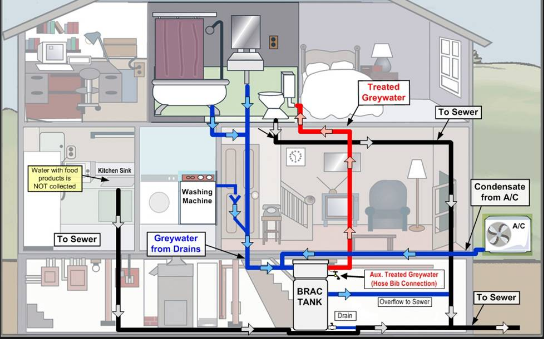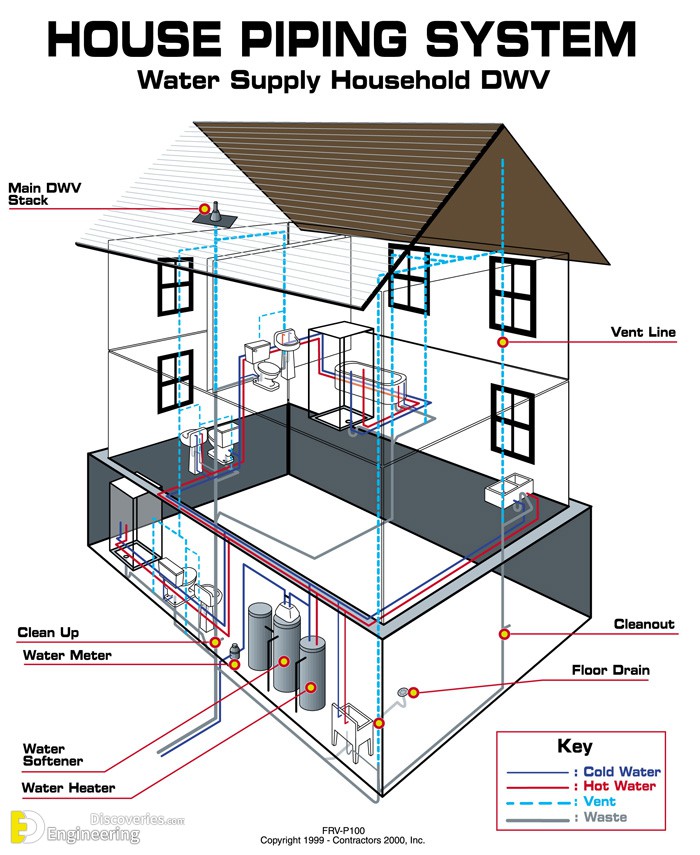Exploring Your House's Plumbing System Anatomy
Exploring Your House's Plumbing System Anatomy
Blog Article
Any individual has got his or her own assumption in relation to The Inner Workings of Your Home's Plumbing.

Recognizing exactly how your home's plumbing system functions is vital for each home owner. From delivering clean water for alcohol consumption, food preparation, and bathing to securely removing wastewater, a properly maintained plumbing system is crucial for your household's health and wellness and comfort. In this extensive overview, we'll explore the intricate network that makes up your home's plumbing and offer suggestions on maintenance, upgrades, and managing common issues.
Introduction
Your home's plumbing system is greater than just a network of pipes; it's an intricate system that ensures you have access to clean water and reliable wastewater elimination. Knowing its elements and just how they work together can assist you stop pricey repair services and ensure whatever runs efficiently.
Standard Elements of a Plumbing System
Pipelines and Tubes
At the heart of your pipes system are the pipelines and tubing that carry water throughout your home. These can be made of various materials such as copper, PVC, or PEX, each with its benefits in regards to longevity and cost-effectiveness.
Components: Sinks, Toilets, Showers, and so on.
Components like sinks, bathrooms, showers, and tubs are where water is utilized in your home. Recognizing just how these fixtures connect to the pipes system assists in detecting troubles and intending upgrades.
Shutoffs and Shut-off Points
Shutoffs regulate the flow of water in your pipes system. Shut-off shutoffs are essential throughout emergencies or when you require to make fixings, permitting you to separate parts of the system without interrupting water circulation to the entire residence.
Water Supply System
Key Water Line
The primary water line attaches your home to the community water or a personal well. It's where water enters your home and is dispersed to various fixtures.
Water Meter and Stress Regulatory Authority
The water meter procedures your water usage, while a pressure regulator ensures that water streams at a safe pressure throughout your home's pipes system, stopping damage to pipes and components.
Cold Water vs. Warm water Lines
Recognizing the difference in between cold water lines, which supply water directly from the major, and hot water lines, which carry heated water from the water heater, aids in fixing and planning for upgrades.
Water drainage System
Drain Pipes and Traps
Drain pipelines bring wastewater away from sinks, showers, and commodes to the drain or septic tank. Catches avoid sewer gases from entering your home and likewise trap particles that might create blockages.
Ventilation Pipelines
Ventilation pipelines allow air right into the drain system, preventing suction that might slow water drainage and trigger catches to empty. Correct ventilation is important for keeping the stability of your pipes system.
Value of Proper Water Drainage
Guaranteeing correct drain protects against backups and water damage. Consistently cleaning up drains pipes and preserving catches can avoid pricey repair work and expand the life of your plumbing system.
Water Heating System
Sorts Of Water Heaters
Water heaters can be tankless or typical tank-style. Tankless heaters warm water on demand, while storage tanks save heated water for instant use.
Updating Your Plumbing System
Reasons for Updating
Updating to water-efficient components or replacing old pipes can boost water quality, minimize water bills, and enhance the worth of your home.
Modern Pipes Technologies and Their Benefits
Explore innovations like smart leakage detectors, water-saving toilets, and energy-efficient water heaters that can save cash and lower ecological effect.
Price Considerations and ROI
Calculate the in advance expenses versus lasting financial savings when considering pipes upgrades. Several upgrades spend for themselves through reduced utility bills and fewer repair work.
Just How Water Heaters Attach to the Plumbing System
Understanding how water heaters connect to both the cold water supply and hot water circulation lines aids in detecting concerns like insufficient warm water or leakages.
Maintenance Tips for Water Heaters
Frequently flushing your water heater to eliminate sediment, checking the temperature settings, and evaluating for leakages can expand its life-span and enhance power effectiveness.
Typical Plumbing Problems
Leaks and Their Causes
Leakages can take place as a result of maturing pipes, loose fittings, or high water pressure. Addressing leakages without delay stops water damage and mold development.
Blockages and Blockages
Clogs in drains pipes and commodes are typically triggered by flushing non-flushable items or a buildup of oil and hair. Utilizing drain displays and bearing in mind what decreases your drains can avoid clogs.
Indicators of Plumbing Problems to Expect
Low tide pressure, slow drains, foul odors, or uncommonly high water bills are indicators of possible plumbing troubles that need to be attended to immediately.
Plumbing Upkeep Tips
Routine Inspections and Checks
Set up yearly pipes evaluations to capture problems early. Look for indicators of leaks, deterioration, or mineral accumulation in taps and showerheads.
DIY Upkeep Tasks
Easy jobs like cleaning tap aerators, checking for toilet leakages utilizing color tablets, or shielding subjected pipelines in chilly environments can prevent significant plumbing problems.
When to Call a Professional Plumbing Technician
Know when a plumbing problem calls for expert expertise. Trying complex fixings without proper understanding can lead to even more damage and greater repair expenses.
Tips for Lowering Water Usage
Basic habits like fixing leaks without delay, taking shorter showers, and running full tons of washing and dishes can save water and lower your utility costs.
Eco-Friendly Pipes Options
Consider sustainable pipes products like bamboo for flooring, which is durable and green, or recycled glass for countertops.
Emergency Readiness
Actions to Take During a Plumbing Emergency
Know where your shut-off shutoffs are located and exactly how to shut off the water supply in case of a ruptured pipeline or significant leak.
Importance of Having Emergency Get In Touches With Convenient
Keep contact info for regional plumbing professionals or emergency situation solutions conveniently offered for quick response during a plumbing dilemma.
Ecological Impact and Conservation
Water-Saving Fixtures and Appliances
Installing low-flow faucets, showerheads, and toilets can substantially reduce water use without giving up efficiency.
Do It Yourself Emergency Situation Fixes (When Applicable).
Temporary repairs like using duct tape to patch a dripping pipeline or positioning a pail under a leaking faucet can reduce damages up until an expert plumbing technician gets here.
Verdict.
Recognizing the makeup of your home's pipes system encourages you to keep it properly, conserving money and time on repair services. By following regular upkeep regimens and staying informed about modern-day pipes modern technologies, you can guarantee your plumbing system operates successfully for several years to find.
Exploring Your Homes Plumbing Anatomy
Water Supply System
Main Water Line: This is where water enters your home from the municipal supply or a private well. Water Meter: Typically located near where the main water line enters the property, it measures the amount of water used. Shutoff Valve: It s crucial to know where this is in case of emergencies. It allows you to turn off the water supply to the entire house. Pipes and Fittings: These distribute water throughout your home. Materials can include copper, PVC, or PEX. Drain-Waste-Vent (DWV) System
Drains: Located in sinks, showers, and tubs, these carry wastewater away. Traps: U-shaped pipes under sinks that hold standing water, blocking sewer gases from entering the home. Vents: Pipes that lead from the DWV system to the outside, preventing vacuum formation and allowing gases to escape. Sewer Line: Carries all wastewater from the home to the municipal sewer system or a septic tank. Fixtures and Appliances
Sinks, Toilets, and Showers Dishwashers and Washing Machines Water Heaters Maintenance Tips
Regularly check for leaks in exposed pipes and around fixtures. Inspect the water heater annually for signs of wear. Clean drains and traps to prevent clogs and odors. Know how to shut off water to individual fixtures. When to Call a Professional
Major leaks or burst pipes Installation of new pipes or fixtures Septic tank issues Remodeling projects that involve plumbing changes Conclusion
Understanding the anatomy of your home's plumbing is key to maintaining a functional and efficient system. Regular checks and knowing when to call in the experts can save you time, money, and stress.
https://www.mavyn.com/blog/exploring-your-homes-plumbing-anatomy

I discovered that article on Anatomy of a House: Understanding the Components when doing a lookup on the search engines. Appreciated our review? Please quickly share it. Help somebody else locate it. We value reading our article about Exploring Your Homes Plumbing Anatomy.
Click Here Report this page